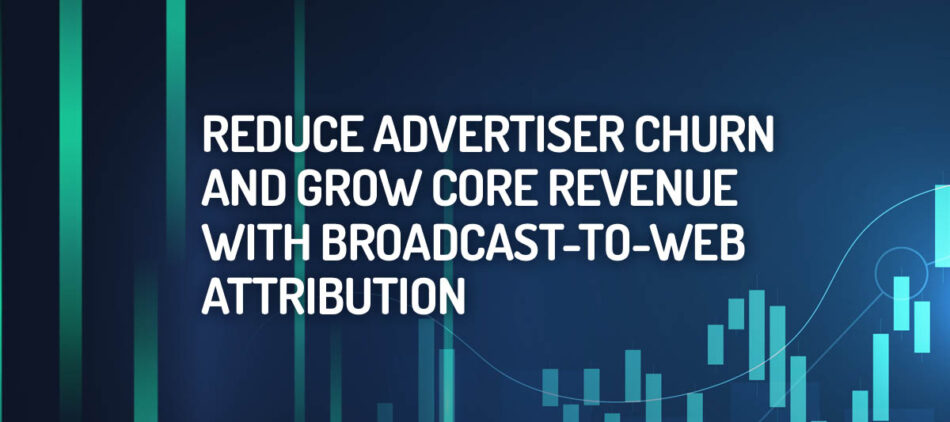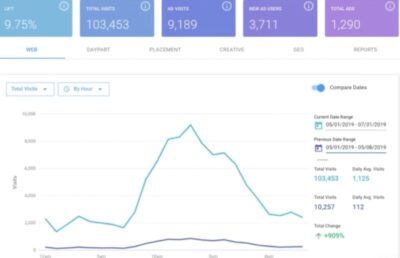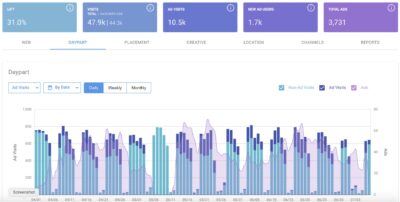
Reduce Advertiser Churn and Grow Core Revenue With Broadcast-to-Web Attribution
Summary:
- Linear broadcasting is still a popular choice for consumers, but how advertisers quantify data is vital to success
- To keep up with the competitive landscape of TV and radio advertising, broadcasters and advertisers are still seeking the best approach to measuring the success of their campaigns
- Investing in attribution helps broadcasters acquire and retain advertising clients in the age of outcome
Broadcast-to-web attribution enables you and your advertisers access to valuable data from over-the-air, linear broadcasting. Broadcast-to-web attribution looks at the correlation between when a listener, or viewer, hears or sees a spot and then takes action—such as visiting the advertiser’s website within a specific aperture of time.
Let’s take a closer look at how attribution enables advertisers to overcome challenges from linear broadcasting, and track valuable insights that lead to a successful campaign.
How do broadcasters and advertisers use broadcast-to-web attribution?
In the past, metrics of success have been challenging to quantify in traditional broadcasting, but now, with sophisticated tools such as broadcast-to-web attribution, broadcasters can more effectively compete with performance-based mediums.
At the same time, advertisers can gain access to data-driven insights on broadcast ad placements of all formats, including pre-produced spots, organic mentions, and live reads, with website response data in near real-time.
As a broadcaster, you can use these data-driven insights to inform ad optimization strategies, increasing customer ROI, resulting in more renewals and greater spend for your properties
Challenges broadcasters and advertisers face
Outcome metrics have been historically challenging to measure from over-the-air, linear broadcasting, even more so in a timely fashion. Advertisers—including local direct advertisers—are demanding metrics that show which ad dollars and which mediums are working. They are accustomed to getting these metrics from digital, which puts traditional media at a disadvantage when they cannot show the value they are delivering relative to competitive mediums.
We’ve all heard the old philosophical question: “If a tree falls in the forest, and no one is around to hear it, does it make a sound?” Similarly, if an advertiser is unable to measure response from a campaign, did the campaign work? That is the dilemma facing advertisers every day as they determine where and if to allocate ad spend.
Being able to access reliable data is a long-standing problem for advertisers and marketers that utilize broadcast mediums. When data is available, it’s often so delayed that it does not reach the advertiser until after the campaign is over, delaying time-critical decision making.
Conversely, when spending money in digital mediums, data is often available in near-real time. Therefore, it’s never been more important to clearly understand and share performance metrics to level the playing field between broadcast and digital mediums.
Advertising dollars continue to shift towards data-driven mediums that are measurable as they search for ways to drive incremental outcomes most cost-effectively. That said, linear TV and terrestrial radio have remained highly effective at reaching a wide audience due to their reach and efficiency.
Linear broadcasting is here to stay
Despite all the options for streaming shows, linear programming is still a popular choice for consumers. According to Nielsen’s Total Audience report, TV and radio still command the highest share of collective trust in advertising. In fact, 60% of people 35-49 consider radio spots very or somewhat trustworthy, with TV not far behind with this demographic at 59%. TV consumption remains healthy and radio remains the #1 reach medium, reaching 88% of American adults each week.
Although younger demographics spend more time on digital platforms, they do this in combination with linear broadcasting. Many consumers still tune into traditional TV to watch live events, sports, and news.
TV and radio broadcasters are turning this medium into a performance-based channel by quantifying and proving campaign success. Broadcast-to-web attribution enables instant access to data-driven insights to inform customers’ ad optimization strategies and increase ROI while driving customer investment. The ability to cost-effectively measure linear broadcasting has allowed markets to capitalize on new opportunities.
Benefits of using broadcast-to-web attribution
Broadcast-to-web attribution allows advertisers to better determine which messages are performing well with their audiences. With actionable insights, they can advise their customers throughout the campaign, helping to optimize campaign performance and budget allocation.
These insights can include:
- Daypart and station analysis
- The ability to A/B test creative
- Geographies the response is originating from
- How many new users are visiting the advertiser’s website
Broadcasters can provide these insights to their advertisers by obtaining read-only access to the advertiser’s website analytics, and correlating it with station as-run and post logs. This correlation of all broadcasted advertisements and in-content mentions, with transcription of audio, logo detection and on-screen character recognition, aids in gaining a comprehensive understanding of the performance of ads.
Here is an example of what an advertiser or account executive might see after connecting their Google Analytics with the platform.
The total lift of website traffic, ad visits over the campaign period, new users and visitors, and total ads. The dashboard will also allow for a comparative analysis of web traffic before and after the campaign started.

You can easily perform analysis with metrics on day of the week, frequency, time of day, location, length, creative and more.

With broadcast-to web attribution, advertisers are able to read data points seamlessly, optimize campaigns, plan media budgets, and make strategic decisions efficiently.
Who should use broadcast-to-web attribution?
Gone are the years that linear broadcast advertisements were only used for brand awareness. Now that data insights have become more accessible, marketers are able to advertise on these platforms more effectively.
Broadcasters can now leverage attribution data to drive customer satisfaction and improve a campaign’s performance. Everything from website tracking after an ad airs, to customer insights can help drive performance-based campaigns. Broadcasters can also adjust copy when necessary, and use real-time analytics to inform campaign decisions
Start improving your ROI with performance metrics for advertisements
There’s never been a better time to get started. Incorporate attribution into your 2022 plans and budgets. Get started now, absolutely free for the remainder of 2021!
Arm your sales managers and account executives with the tools they need today to lock in annual renewals and start growing your share of spend in 2022.